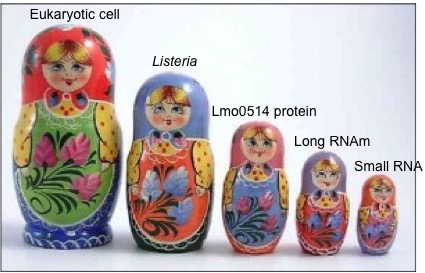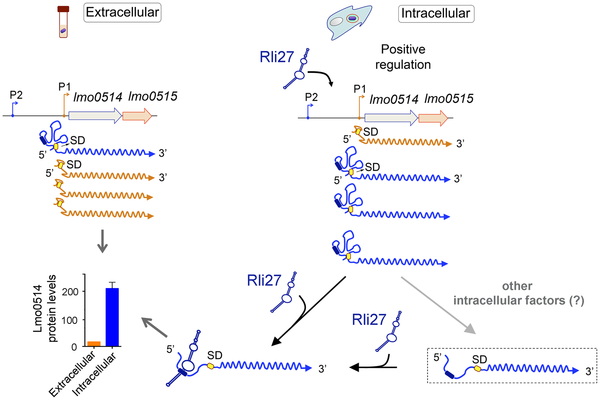RNAs, proteins, Listeria and cells: the microbial version of the Russian doll game
Listeria monocytogenes is a food-borne Gram positive bacteria that causes the infection listeriosis. It is responsible for serious clinical manifestations including gastroenteritis, and meningitis and encephalitis in newborns, with 20 to 30 % of clinical infections resulting in death. Itis a facultative intracellular pathogen that caninvade and move within eukaryotic cells by polymerization of actin filaments. The life cycles followed by this pathogen are highly complex, since this microorganism must survive in varied and changing conditions ranging from the open environment to the intracellular medium. For this, the bacterium must coordinate an intricate network of factors to generate a suitable adaptive response to the various signals.
Genome studies have shown that Listeria has several proteins that bind covalently to the peptidoglycan in the cell wall. Some of these proteins are essential for the virulence of the bacteria and their level of expression change on adaptation to different environments. One of these proteins, named Lmo0514 and of unknown function, is overexpressed when the bacteria is inside the eukaryotic cell. The mechanism that regulates the production of this protein remains unknown.
Now an elegant paper 1 of the group of our colleague Francisco García-del-Portillo from de Centro Nacional de Biotecnología (CNB, CSIC, España) describes how the bacteria Listeria regulates the expression of Lmo0514 protein levels inside our cells. The way that this protein is produced preferentially when the bacteria is inside the eukaryotic cell reminds us the Russian doll game. Let see first the dolls.
- The host: JEG-3 human epithelial cell, a eukaryotic cell.
- The bacteria Listeria monocytogenes: a facultative intracellular pathogen that expresses a number of virulence factors that promote entry into eukaryotic cells, intracellular survival and proliferation, and spreading to adjacent cells.
- The protein, Lmo0514: a Listeria monocytogenes surface protein covalently anchors to the cell wall. Lmo0514 is more abundant (> 200-fold) in the cell wall of bacteria that proliferate inside eukaryotic cells that in bacteria growing in laboratory media.
- The long RNAm: a RNA transcript of Lmo0514 protein with a long (234 nucleotides) untranslated region (UTR) in the 5´end (long 5´-UTR-lmo0514), upregulated and detected specifically in the intracellular bacteria.
- The short RNAm: a RNA transcript of Lmo0514 protein with a short (28 nucleotides) untranslated region (UTR) in the 5´end (short 5´-UTR-lmo0514), detected specifically in bacteria growing extracellularly in laboratory media.
- The small RNA, Rli27: a 130 nucleotide small RNA of Listeria monocytogenes. Bacterial small RNAs have regulatory functions and are not predicted to encode any protein. Rli27 expression is induced (20-fold) in intracellular bacteria when compared with extracellular bacteria grown in rich medium. Rli27 is a small RNA that is upregulated by Listeria monocytogenes inside eukaryotic cells.
Now, let see how they fit together the small inside the big one:
Listeria monocytogenes is inside the eukaryotic cell. The small RNA Rli27 is produce by Listeria monocytogenes when it is inside the cells. This small RNA interacts physically with the 234-nucleotide specific sequence of the 5´-UTR end in the lmo0514 long RNAm, and not with the short version of the RNAm. This interaction promotes the production of the Lmo0514 protein inside the eukaryotic cell. The Rli27 interaction with the long RNAm is essential to increase the Lmo0514 protein levels in intracellular bacteria.

It sounds very simple, like a dolls game, but this information is particularly important for understanding how a Gram positive pathogen such as Listeria, which produce a large arsenal of surface proteins necessary for the virulence, can regulate its expression when the bacteria is inside the cell.

This work demonstrates that the limited amounts of the small RNA (the regulator) and the long RNAm (the target) in the bacteria when it is outside the eukaryotic cell ensure that production of the bacterial cell protein is confined mainly to the host rather than the non-host environment. Transcriptomic studies show that approximately 100 genes of Listeria have long 5´-UTR RNA transcripts. As several of these genes are virulence-related genes, the results presented in this paper suggest that the microbial version of the Russian doll game could be the way by which Listeria regulates its genes when it is inside the eukaryotic cell.
References
- Quereda J.J., M. Graciela Pucciarelli & Francisco García-del Portillo (2014). The Listeria Small RNA Rli27 Regulates a Cell Wall Protein inside Eukaryotic Cells by Targeting a Long 5′-UTR Variant, PLoS Genetics, 10 (10) e1004765. DOI: http://dx.doi.org/10.1371/journal.pgen.1004765 ↩
3 comments
[…] Errusiar panpinen edo matrioxken antza du bakterio patogeno batek nola erregulatzen duen, haren birulentzian eragiten duen, proteina ekoizpena. Ignacio López-Goñiren artikuluan ikus daiteke: RNAs, proteins, Listeria and cells: the microbial version of the Russian doll game. […]
[…] regula la producción de proteínas que afectan a su virulencia recuerda a las muñecas rusas. RNAs, proteins, Listeria and cells: the microbial version of the Russian doll game por Ignacio […]
that’s really helpful my paper, thanks!